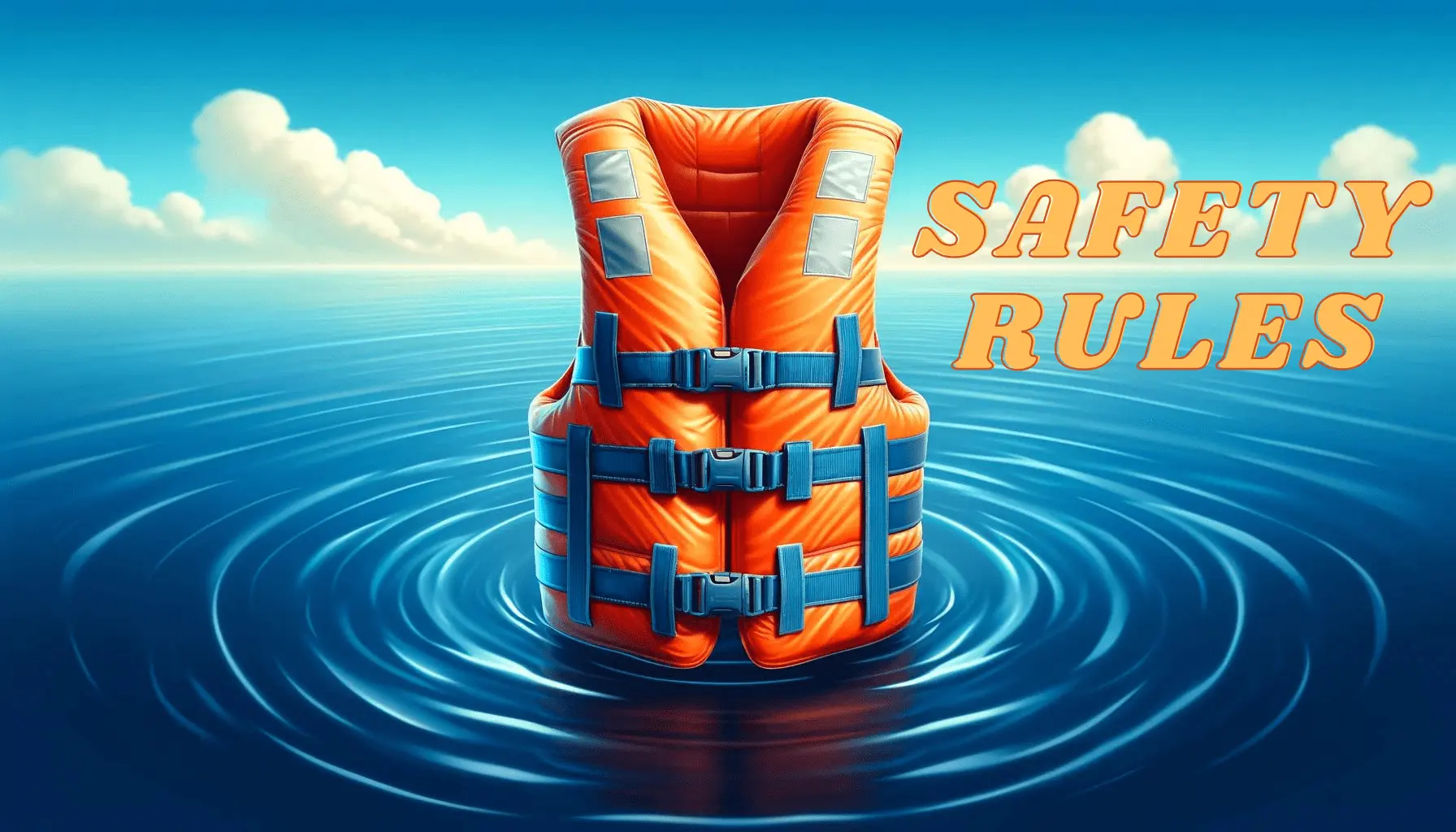When trying to figure out how to transport your kayak on a small car, safety and complying with laws should always be your top priorities. You want to avoid any potential accidents or damage to your car or kayak, and I’m guessing you’re also not too thrilled about paying fines. That’s why it’s absolutely crucial to check whether your kayak is too big for your car.
But even if you have a small car with no rails, you can still safely transport your kayak. The first thing to keep in mind is that most kayaks aren’t too heavy. This gives you a few options to consider.
If you’re up for it, you can choose to lift and strap down the kayak on your own. But, if you prefer a bit of assistance, I’ll be sharing some handy techniques with you shortly.
This article contains practical information you need to safely transport your kayak on a small car legally.
Let’s dive in.
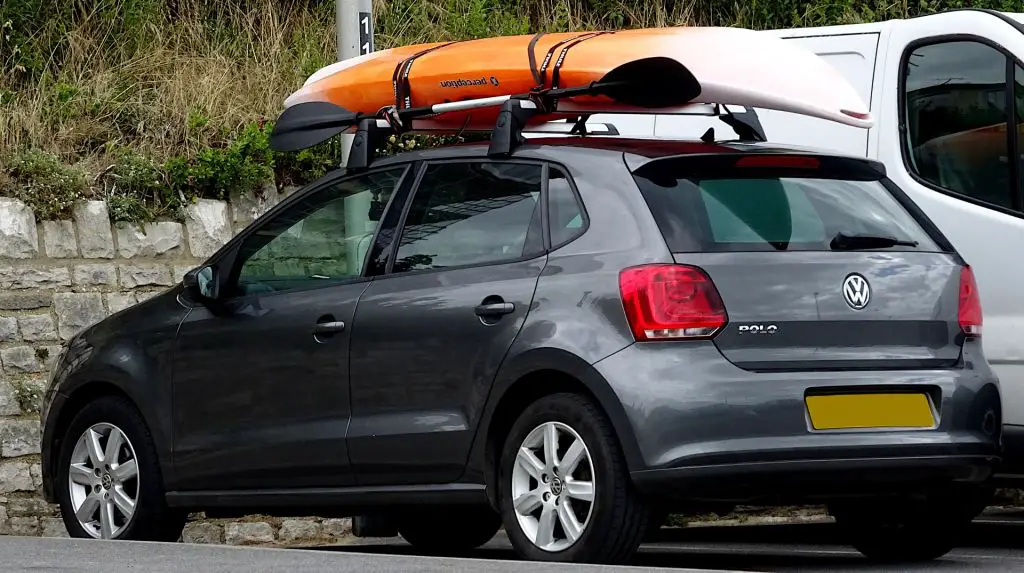
The Best Methods To Transport A Kayak On A Small Car
If you have a small pickup truck, you’re lucky. This should be easy, so long as you don’t overextend your load. And if your car has rails or gutters, you’ll find the most recommended and safest way to move your kayak from point A to point B on a small car in the next section.
But If your car has no fixed points, don’t worry; there are still options for you to secure and transport your ‘yak. Let’s explore some:
Install A Roof Rack
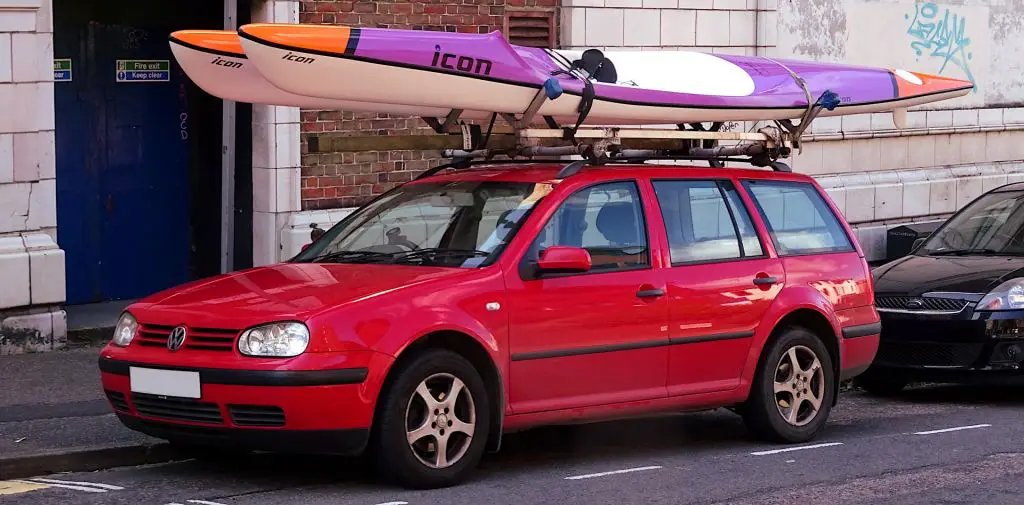
Roof racks are your safest bet. They’ll save you from the worry of damaging your car’s roof, and provide a secure spot for your kayak, and you’ll lessen your odds of getting in trouble with the law for an oversized load.
To get started, you have to ensure your car has crossbars. They are usually necessary for installing a roof rack.
You’ll come across many different kayak roof racks for small cars. There’s a wide variety to choose from, each with its own pros and cons. Some racks can hold just one kayak, while others can handle multiple ones. You’ll also find racks that are a breeze to install and others that require a bit more elbow grease.
Once you’ve got your hands on the perfect kayak roof rack, center your kayak on the roof rack, following instructions in the manual. Trust me, proper centering makes all the difference. It not only keeps your kayak secure but also reduces the chances of any unexpected wobbling on the road.
Now comes the important part—securing your kayak. You’ll need straps or bungee cords for this. Fasten them nice and tight, so your kayak won’t budge an inch until you’re ready to unload.
Remember, it’s all about finding that sweet spot between a snug fit and avoiding any unwanted deformations to your ‘yak.
Use Hullavators
These specialized carriers revolutionize loading and unloading your kayak, even for smaller vehicles.
Hullavators feature a powerful lift-assist mechanism, effortlessly handling up to 40 lbs of the kayak’s weight. You won’t strain as much or rely on others for help lifting the kayak. They have gas-assist struts, and they smoothly lift and lower the kayak, making the process a breeze.
Hullavators also offer convenient waist-height loading. Using their extending arms, you can easily lower the kayak by up to, like, 3 feet. So you don’t have to keep awkward bending to effortless loading at a comfortable height.
Protecting your kayak and car from scratches is also a concern, and Hullavators, with their 8 padded support points and corrosion-resistant cradles that expand for wider kayaks, keep your kayak safe during transportation.
Foam Blocks Or Pool Noodles
Pool Noodles
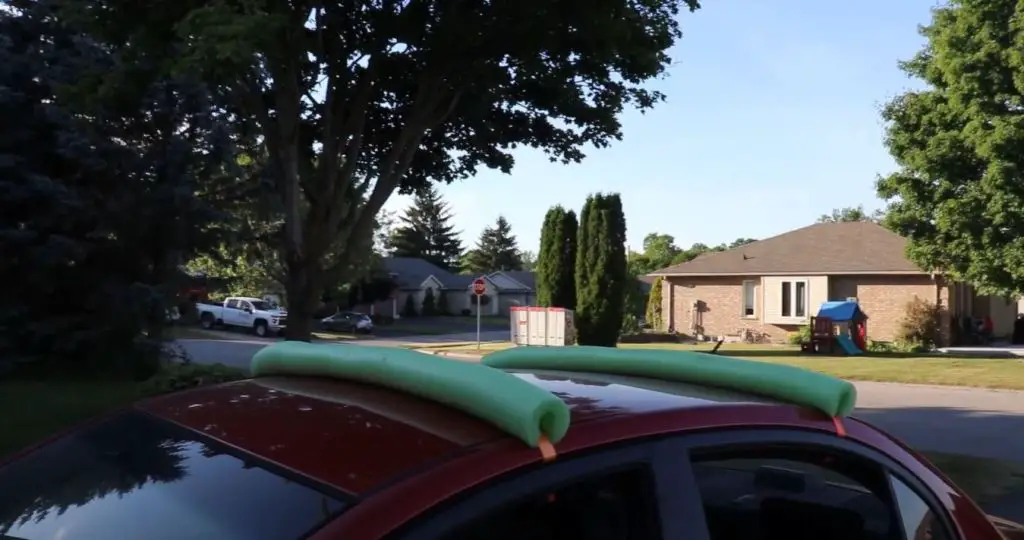
If your car’s roof doesn’t have crossbars for a roof rack, don’t fret. You still have alternative options like pool noodles or foam blocks for safe transport.
Pool noodles are cylindrical foam pieces that can act as a protective barrier between your kayak and the car roof. They work just as well as a substitute for traditional roof racks if you set them up right.
To set up pool noodles as a makeshift kayak rack for a small car:
- Place the pool noodles horizontally on the car’s roof, making them stretch from the passenger side to the driver’s side.
- Then, create enough space between the pool noodles to fit your kayak’s cockpit.
- Make sure the pool noodles are shorter than the width of your car.
- Thread your cam straps through the pool noodles, ensuring equal lengths on each end.
- Insert stainless steel or aluminum tubes into the pool noodles for added stability.
- Position the pool noodles in place, run the cam straps underneath the roof, and tighten them securely.
- Use additional straps to tightly secure your kayak. (Not too tight or loose, as mentioned earlier.)
Foam Blocks
Foam blocks are another option for creating a kayak rack that may work for you. As you know, properly distributing the weight of the kayak and centering it on your car’s roof is crucial for a mode of secure transport. You can set them just as you would noodles, as shown below.
While using foam blocks and the car’s roof can be a cost-effective option, it’s important that you are aware of potential drawbacks.
For instance, without a thorough cleaning, grit can cause scratches, and repeated use of foam blocks may result in wear on the car’s clear coat or paint. If you ensure good weight distribution and take precautions, you’ll minimize these risks.
- Obtain two foam blocks of appropriate size.
- Set the foam blocks apart, leaving enough space for your kayak’s cockpit.
- Place your kayak on top of the foam blocks, facing down.
- Use cam straps to firmly secure the kayak to your car roof. You may need multiple cam straps.
If you go with pool noodles or foam blocks, you can safely transport your kayak on a small car even without a traditional roof rack. Remember to double-check the strap’s tightness before hitting the road.
Using Inflatable Or Foldable Kayaks
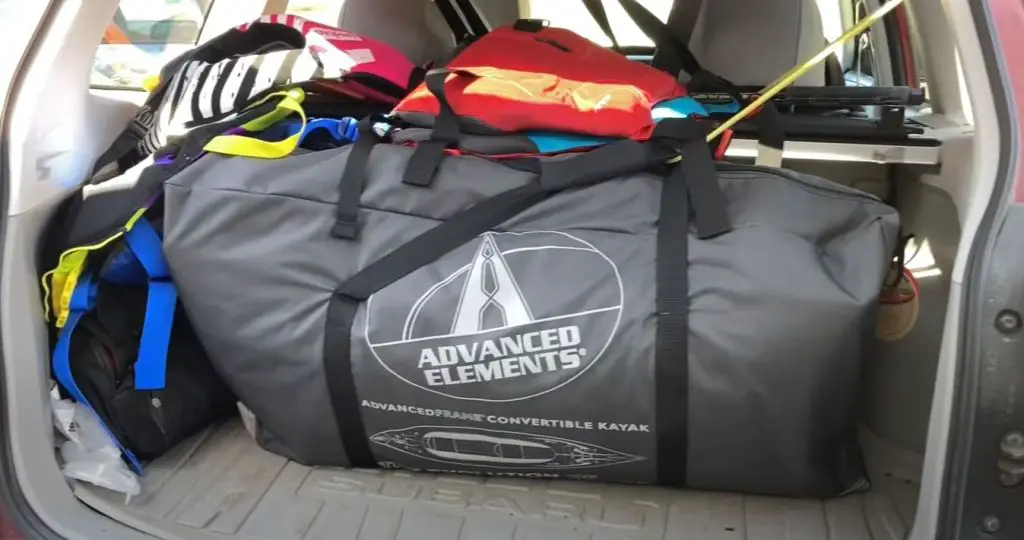
Inflatable kayaks, though not as maneuverable on the water, offer unbeatable convenience and portability. They can be folded or deflated to fit in your car’s trunk or backseat, so there’s no need for external carriers.
This portable option ensures your kayak stays put and can’t scratch your car during transit. Modern inflatable kayaks are known to deliver stability and comfort, making them suitable for various paddling conditions, but their performance may not match that of hardshell boats.
Just be cautious when loading them to prevent water or contaminants like mold and dirt from entering your vehicle. Always ensure that the kayak is dry and clean before packing it away after you leave the beach, not before heading out, and consider using protective covers or bags to keep it in top condition during transport.
Exploring The Use Of A Trailer
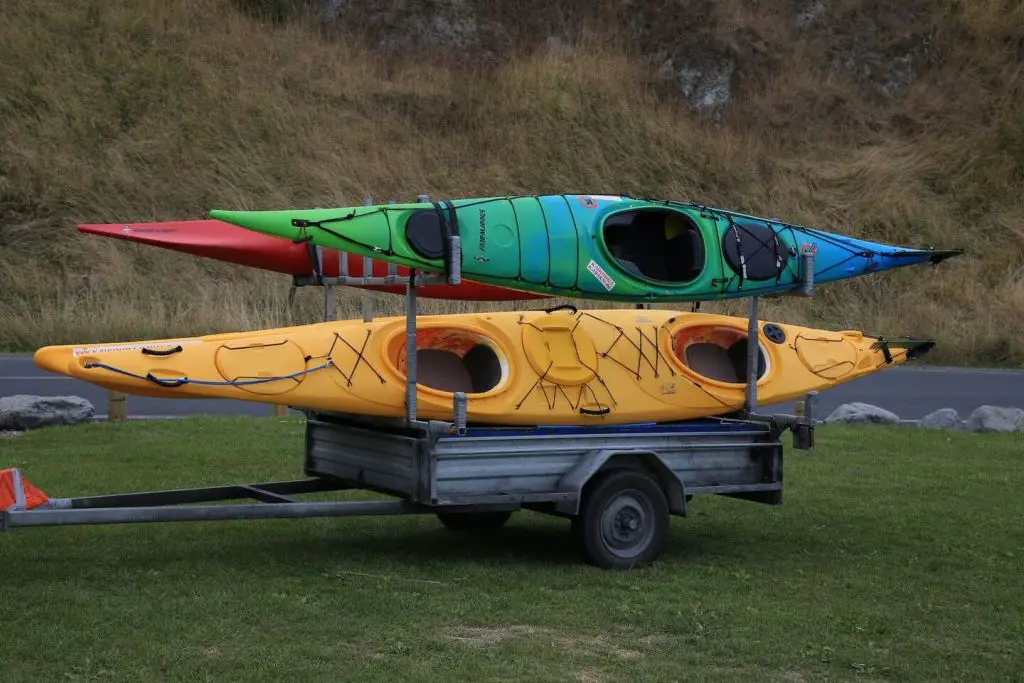
Another way to make transporting your kayak effortless is with a kayak trailer. These trailers are designed specifically for carrying kayaks and gear and come in various sizes to accommodate your exact kayak type. They have a sturdy frame and two small wheels that attach to your vehicle, making moving your stuff way less time consuming.
When you’re choosing a trailer, check its weight rating to confirm it can safely handle the load. Also, check the size of your kayaks, oars, and gear to ensure they fit properly on the trailer.
If you’re unsure, just consult your yak’s owner’s manual or check online to determine if it’s the right fit.
Also, ones with handy features such as adjustable racks, tie-down points, and additional storage options could be plenty useful. These features can enhance the convenience and functionality of the trailer, allowing you to routinely transport your kayaks and equipment in little time.
Some kayak trailers you’ll find offer the flexibility to transport multiple kayaks at once. You may prefer them for group outings if you’re a family with multiple kayaks. These trailers typically have larger capacities and may include stacker or rack systems to accommodate multiple kayaks in a space-efficient manner.
It’s also worth mentioning that kayak trailers can be a versatile solution beyond just transporting kayaks. With their adaptable design, they can be used to carry other outdoor equipment such as canoes, paddleboards, or even camping gear, providing added versatility for your outdoor adventures.
Rent a Kayak Locally
When the logistics or costs of transporting your kayak in a small car become overwhelming, an excellent alternative is to rent one at your destination. This option is particularly convenient for well-known kayaking spots, where reputable outfitters are often located.
Working with a trusted rental company near your desired kayaking area, you can easily get your hands on a kayak and embark on your adventure hassle-free.
You’ll get to link up with your tribe of kayaking enthusiasts, and it’s advisable that you choose a rental company that not only provides kayaks but also offers additional services like kayak lessons, courses, or guided tours.
This way, you’ll enhance your kayaking skills, gain valuable insights about the area, meet new people, and make the most of your time on the water.
Opting for a rental company with these added benefits can greatly enrich your kayaking experience and ensure that you have a safe and enjoyable time exploring new waters. You can also forget about running into legal problems with how you transport your yak.
Legal Requirements

Ensuring the safety of your kayak and your small car while observing traffic laws during transportation should be your utmost concern, as I have said earlier. If not, you may get fined or face jail time, depending on where you are.
If you notice that more than half of the kayak extends beyond your vehicle after loading, please avoid proceeding with that method. When you leave a significant portion of the kayak unsupported, you can create hazardous conditions and increase the risk of accidents or damage.
To prevent any disruptions from the cops during your trip, take the time to familiarize yourself with the relevant laws in your state, along your travel route, and at your destination regarding the transportation of kayaks or other loads on your car’s top.
Different jurisdictions may have specific regulations in place, but some apply to most places, such as the requirement to attach a bright red flag to any part of the kayak that extends beyond the rear of your vehicle or trailer.
These laws exist to prioritize road safety and mitigate potential risks.
Federal law requires that if your car’s projected load is 2 feet wide or less, only one warning flag is needed. However, if the load exceeds 2 feet in width, two flags must be used.
These flags should mark the maximum width and length of the projection. Follow these requirements so you don’t get fines and tickets.
Unsecured loads that go on to lead to road debris are a major cause of traffic accidents, as confirmed by research from the AAA Foundation for Traffic Safety. So it is no surprise that falling objects from a moving vehicle are illegal throughout the United States and will definitely land you in trouble.
15 states have implemented specific laws that address the hauling of unsecured loads, some of which carry the potential for jail time as a consequence. It’s that serious.
Transporting loads without proper security is a disaster waiting to happen, posing real safety risks to both vehicles and pedestrians. So it’s not only your legal obligation but also a responsibility to prioritize the safety of everyone on the road.
Navigating The Road: Tips For Driving With A Kayak On Your Car
When you’re planning to hit the road with a kayak strapped to your car’s roof, pay close attention to the following points before you depart:
Adjusting Your Driving Style: Speed, Turns, and Braking
Give ample space: Always stay aware of the extra length and width added by the kayak on your car so you can allow for more space when changing lanes or merging with other vehicles to avoid any potential contact. And drive slowly so your kayak is not dislodged in case you didn’t secure it well.
Signal your intentions: As always, use your turn signals in advance to communicate your intentions to other drivers as you drive slower than usual. Signaling early and clearly will give them a chance to peep at your movements and adjust their driving accordingly.
Stay in your lane: Maintain a steady position within your lane to provide a predictable driving pattern for other motorists, and don’t speed through corners. Avoid sudden swerving or drifting, which could startle or confuse other drivers sharing the road.
Remember to exercise patience and show courtesy towards other drivers. If someone is tailgating or seems impatient, it’s best to maintain your focus, continue driving safely, and don’t react aggressively or engage in road rage.
Regularly Checking Your Load During Your Journey
If you prefer to transport your kayak on the roof of your vehicle, whether you have a roof rack or not, always consider the weight capacity of your car’s roof. More so if you own a heavy kayak, say a fishing kayak.
For the safety of your car, kayak, and others on the road, check with your car’s manufacturer to verify that the roof can handle the weight and won’t dent. Failing to do so could result in damage that could’ve been avoided.
To maintain stability while driving, center your kayak between the crossbars on your car and ensure it is aligned parallel to the vehicle. This proper alignment and positioning helps distribute the weight evenly and minimize any risks of imbalances while on the road.
You can hop out mid journey and double-check and make any necessary adjustments to make sure the grip on your load is just right.
In Conclusion
We have delved into the essential aspects of safely and conveniently transporting a kayak with a small vehicle while complying with relevant laws.
Using roof racks will most likely be the most secure and reliable method for carrying kayaks on top of your car. They offer convenience and ease of use, allowing for efficient loading and unloading of your kayak, but you have to have crossbars on your car.
For those without roof racks, I have discussed the alternative option of using foam boards or pool noodles. While not as sturdy as roof racks, they still act as a protective cushion between the kayak and your car roof. They offer a budget-friendly and accessible solution for transporting your kayak safely.
So if you’re a seasoned kayaker or new to the sport, this post should have valuable insights and practical tips to help you transport your kayak with peace of mind, even when using a small car.

